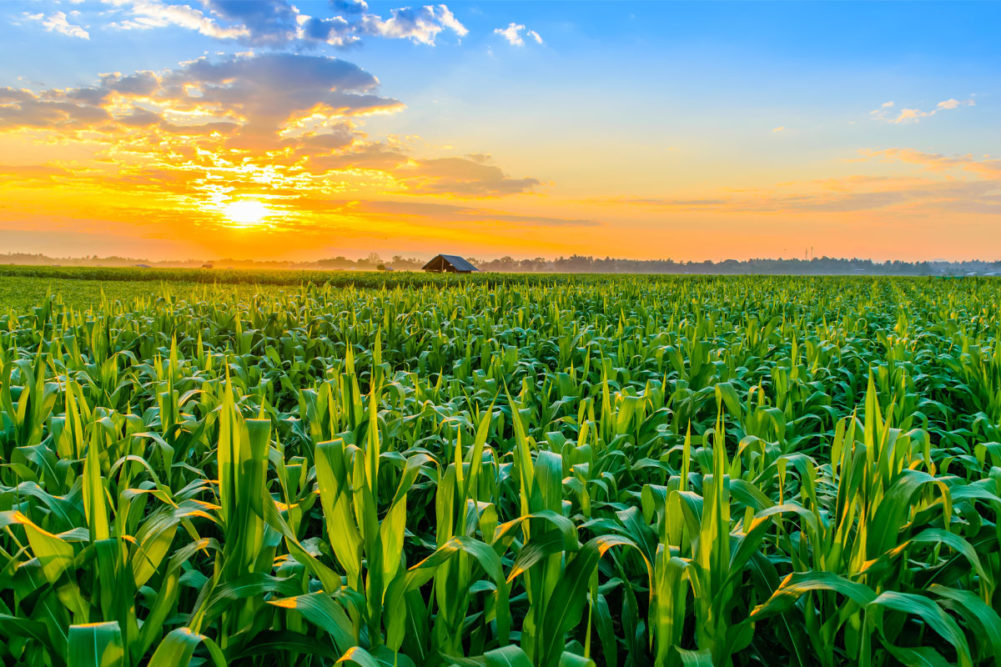KANSAS CITY, MO. — The US Department of Agriculture in its May 12 World Agricultural Supply and Demand Estimates report projected record-high corn and soybean production in 2023 with crop progress and weather forecasts supporting those numbers early in the season.
In its initial projection for the 2023-24 marketing year (for crops harvested in 2023) the USDA forecast US corn production at a record 15,265 million bushels, up 11% from 2022, based on a record-high average yield of 181.5 bushels per acre, up 4.7%, planted area of 92 million acres, up 3.8%, and harvested area of 84.1 million acres, up 6%.
The USDA’s initial 2023 soybean production was forecast at a record 4,510 million bushels, up 5% from 2023, based on an average yield of 52 bushels per acre, up 5%, planted area of 87.5 million acres, unchanged, and harvested area of 86.7 million acres, up 0.5%.
The corn and soybean production and yield projections all were above pre-report trade expectations. Corn futures closed narrowly mixed, and soybean futures closed lower on May 12.
It should be noted the USDA’s May yields forecasts are based on trendline projections, and the acreage forecasts are based on the March 31 Prospective Plantings report data. The first 2023 estimate for corn and soybeans based on farmer surveys and the June 30 Acreage report will be issued Aug. 11. Much can change by that time.
If realized, 2023 corn production would exceed the prior record of 15,148 million bushels set in 2016 by 0.8% and would be the third time production has exceeded 15,000 million bushels since 2016. The soybean forecast, if realized, would edge the prior record of 4,465 million bushels set in 2021 by 1%.
The USDA’s initial projections for 2022 crops issued in May of last year were 14,460 million bushels for corn and 4,460 million bushels for soybeans. The final estimates for 2022 issued in January 2023 were 13,730 million bushels for corn, down 5% from the initial projections, and were 4,276 million bushels for soybeans, down 4%. Adverse weather mainly in the western part of the Corn Belt cut production prospects last year.
But so far in 2023, strong planting progress and the expected arrival of an El Niño weather system, which tends to produce favorable growing conditions in the Midwest, appear supportive of the USDA’s early projections.
Corn was 65% planted in the 18 major states as of May 14, well ahead of 45% at the same time last year and modestly ahead of 59% as the 2018-22 average for the date, the USDA said in its weekly Crop Progress report. Planting completion was 86% in top-producing Iowa and was 84% in Illinois, the second largest corn growing state.
The situation was similar for soybeans, with planting progress as of May 14 at 49% in the 18 major states, ahead of 27% a year ago and 36% as the five-year average.
Favorable weather last week should allow farmers to make rapid progress during the second half of the planting season.
Weather during the rest of the growing season will determine final yield and production numbers. The USDA’s analysis of the May 9 US Drought Monitor showed 29% of corn and 21% of soybeans were within drought areas. Dry conditions mostly were limited to the southern Plains and the western Corn Belt, with nearly all of Nebraska and Kansas in some level of drought. Areas west of the Missouri River, and especially west of the Mississippi River, had minimal areas of drought.
Higher production tends to bring lower prices. The USDA forecast the average price of corn paid to farmers in 2023-24 at $4.80 a bushel, down 27% from 2022-23, and of soybeans at $12.10 per bushel, down 15%.
Strong US corn and soybean production is expected to boost domestic supplies, especially in the face of strong export competition for both commodities from Brazil, which is expected to also have record-large soybean and corn crops in 2023.
Corn exports and use of corn for feed/residual and for food/seed/industrial (which includes ethanol) all were projected higher in 2023-24, but it wasn’t enough to offset the massive increase in production.
For soybeans, domestic crush was forecast higher in 2023-24, but exports were lowered, giving a large boost to stocks.
The carryover of US corn on Sept. 1, 2024, was projected at 2,222 million bushels, up 57% from the 2023 forecast of 1,417 million bushels. Soybean carryover on Sept. 1, 2024, was forecast at 335 million bushels, up 56% from 215 million bushels expected for this year.
If realized, 2024 corn carryover would be the highest since 2017 and the ending stocks-to-use ratio the highest since 2019. Soybean carryover and stocks-to-use in 2024, if realized, would be the highest since 2020. Corn and soybean carryover projections for 2024 were well above trade expectations.
Larger stocks of corn and soybeans and subsequent lower prices should provide buying opportunities for US food manufacturers in the year ahead.



